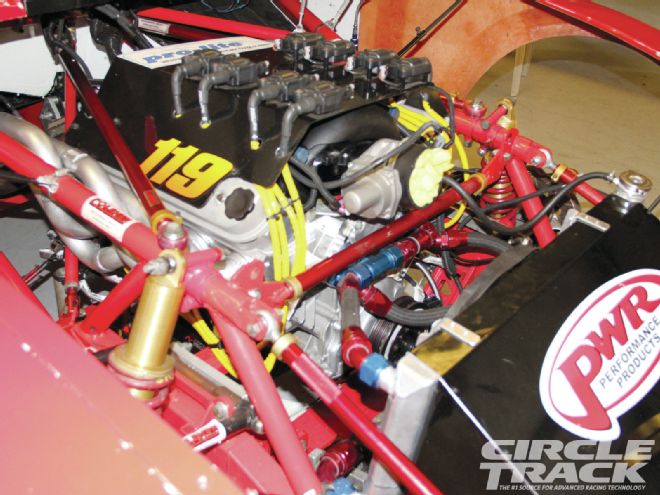
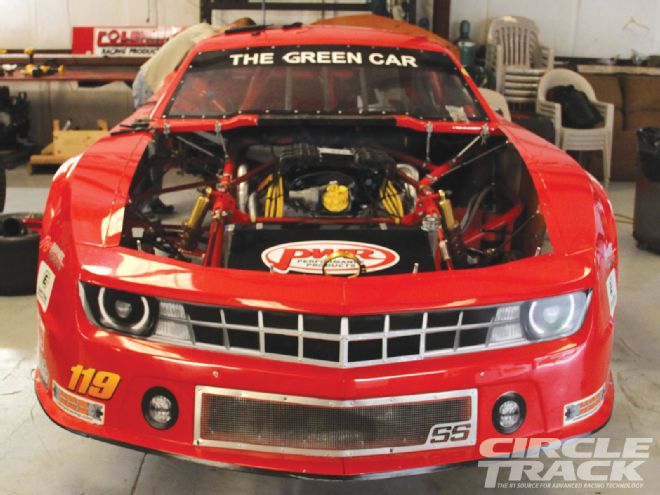 You may not have seen her for a while, but that doesn't mean that the CT Project G.R.E.E.N. team has been ignoring our little red Camaro.
You may not have seen her for a while, but that doesn't mean that the CT Project G.R.E.E.N. team has been ignoring our little red Camaro.
When last we saw Circle Track's Project G.R.E.E.N. Camaro, she was sitting under the bright lights of the Vehicle Technology Center at last year's SEMA Show in Las Vegas, Nevada. And although the car has not recently graced the pages of the magazine, the whole G.R.E.E.N. team has been hard at work planning, structuring, and generally preparing for the next phase of the project.
As a refresher, or for the benefit of new subscribers, Project G.R.E.E.N. was designed as a very special project car that would give Circle Track readers a glimpse into the future of what oval track racing might be like 15, 10, or maybe even just 5 years from now. G.R.E.E.N. actually stands for Green Racing Experimental Engine Narrative, an acronym coined by our very own Bob Bolles. In a nutshell, we wanted to investigate exactly how racey of a car we could build employing modern drivetrain technology and skinning it in a late-model body. Our base engine was Chevrolet Performance's CT525, while the body of the car would be a '10 Camaro. During the course of phase one of the project, we compared carburetion to electronic fuel injection, as well as race gas to pump E85 in a quest to find the best fuel/induction combination for the motor. For a number of reasons, the combination of EFI and E85 won out by delivering an overall 7 percent increase in torque. At least on paper the car should pull very hard off of the corners.
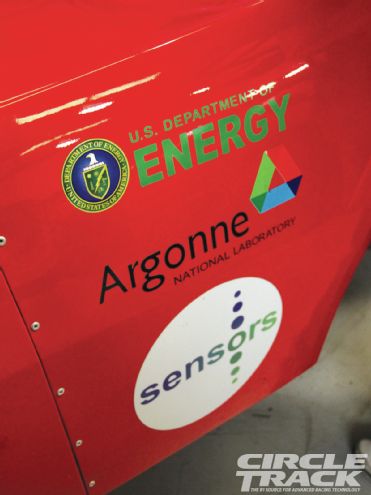 1. Back for Phase 2 of the project are our friends at Argonne National Laboratory.
1. Back for Phase 2 of the project are our friends at Argonne National Laboratory.
In a subsequent test at New Smyrna Speedway with resident CT project car driver Dalton Zehr behind the wheel, the EFI/E85 configuration of the Project G.R.E.E.N. Camaro turned laps 0.5 of a second faster than with traditional carb/race gas. The lap times were truly impressive, but would such a car be able to compete with Midwest Super Late Models? There was only one way to find out. So we packed up the trailer and headed to LaCrosse Fairgrounds Speedway in LaCrosse, Wisconsin for the annual Dick Trickle 99, a 99-lap race that is divided into three 33-lap segments.
Running with the likes of Chris Wimmer, Steve Carlson, Ross Kenseth, and more than 60 other top-notch drivers would be no easy task, but in the end Dalton finished a very respectable 14th. But the best part was we only spent $38 on gas and had approximately $8,500 in the engine. Now anybody who races in a series like the ASA Midwest Tour, where built 9:1 powerplants are the standard bearer knows that you don't normally spend less than $10 g's on a motor and less than $40 in gas for a 100-lap race.
As is typical with many short tracks around the country, LaCrosse opens the pit gates up after the event and allows the fans to meet the drivers and teams. Suffice it to say our little red Camaro had gained a lot of attention on the track, so when the checkered flag fell and fans streamed into the infield at 10 p.m., we had no choice to start talking about the project. When the last fan left, we looked at the clock and it was 1:30 a.m. Project G.R.E.E.N. was truly a success. We'd build a racey car at a low cost that yielded a ton of fan and driver interest and appeal.
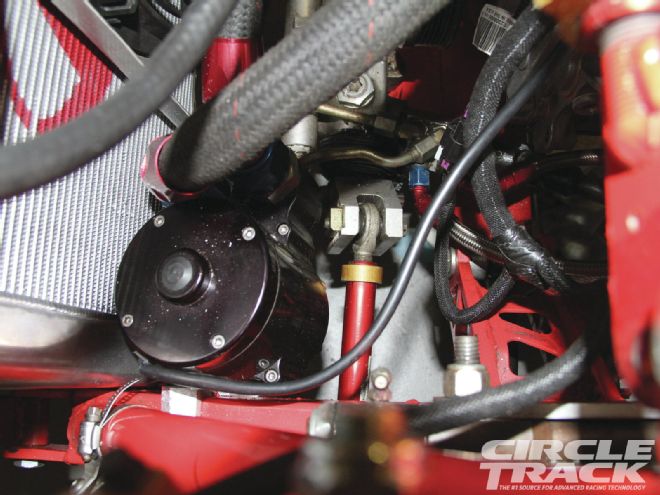 2. Meziere’s electric water pump sits snugly against the radiator. Drawing less than 12 amps and weighing only 6.2 pounds the pump delivers 55 gpm of cooling power.
2. Meziere’s electric water pump sits snugly against the radiator. Drawing less than 12 amps and weighing only 6.2 pounds the pump delivers 55 gpm of cooling power.
The Camaro then made appearances at the 2010 PRI Trade Show in Orlando and SEMA 2011 in Las Vegas accompanied by a comprehensive presentation crafted by our friends at Argonne National Laboratory at both stops. Subsequently, the presentation was given a third time at IMIS-Indy last year.
Prior to the Trickle 99 race we had hauled the Camaro to Argonne National Lab's facility just outside of Chicago for some final instrumentation work on the car so that our engineer gurus Forrest Jehlik and Danny Bocci could gather the data that they needed. It was during a bench racing session at lunch that Dalton hatched an idea that led to Phase 2 of this project upon which we are about to embark. Our 20-something driver, theorized that if we removed everything that was mechanically driven off of the front of the engine, then we should free up horsepower. Items like the water pump and power steering pump should be driven electrically, perhaps by a second battery located remotely toward the rear of the car. Now, there would no longer be a need for an alternator, more free horsepower. Jehlik and Bocci both agreed that it would be easy to do. Then came a flurry of downstream ideas.
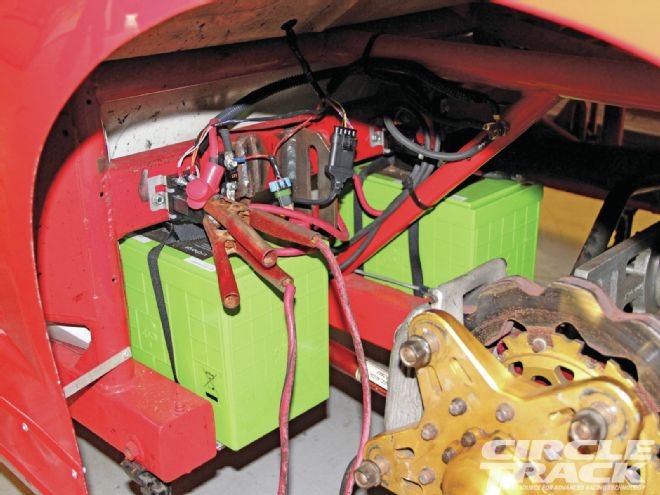 6. The muscles of the system are two Valence Technology lithium-iron magnesium phosphate batteries. And no, that is not a typo in the word iron. Lithium-ion batteries are found in your cordless drill that you bought at Lowe’s. These batteries are hard-core all the way, offering double the run-time at less than half the weight of comparable lead-acid versions.
6. The muscles of the system are two Valence Technology lithium-iron magnesium phosphate batteries. And no, that is not a typo in the word iron. Lithium-ion batteries are found in your cordless drill that you bought at Lowe’s. These batteries are hard-core all the way, offering double the run-time at less than half the weight of comparable lead-acid versions.
"Let's use rechargeable batteries."
"Let's capture spent energy coming off the driveshaft to recharge the batteries."
"Let's divert some of that captured energy to a secondary drive system that could be designed as an on-demand horsepower increase controlled by the driver."
"Let's figure out how to hide all of this and really drive Lumpy nuts." (Ed. Note—If you don't know who Lumpy is, refer to the March '12 issue of Circle Track)
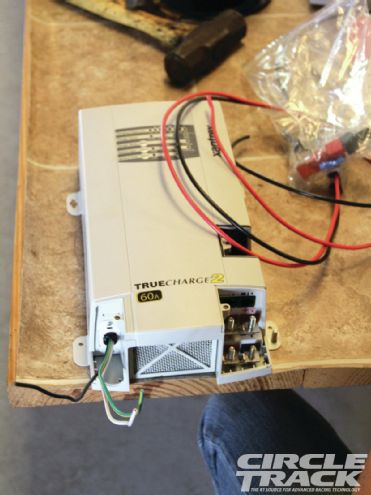 7. The batteries come complete with their own on-board recharging system, aka “that gray box.”
7. The batteries come complete with their own on-board recharging system, aka “that gray box.”
At the risk of entering an arena where we will completely blow the economics of this thing out of the water, we began constructing what would become Phase 2 of Project G.R.E.E.N. Budgets be damned, we decided to break Phase 2 into two separate segments. The first would be focused on electrifying two components that are traditionally mechanically driven in an oval track car, the water pump and the power steering pump. Accomplishing that with a secondary battery would also allow us to ditch the alternator. Once that segment of the project is complete, we would then focus on turning the Camaro into a true hybrid race car. With that cat peeking out of the bag, let's delve into segment one and leave hybridization to your imaginations and for later on in the year.
First order of business was to determine what two pumps we were going to use. Let's face it, electric water pumps or p/s pumps aren't exactly the norm in oval track racing. After some research we chose Meziere's electric water pump, PN WP337S. Weighing just slightly more than 6 pounds, this pump flows 55 gallons per minute through stainless steel hardware. Under normal use the pump will draw 11-12 amps and is just 5.20 inches long from the mounting surface to the tip of the pump. For the power steering unit, we purchased Flaming River's Motorsports Electric P/S System, PN FR40105. The P/S weighs just under 14 pounds, but only draws 8 amps. That coupled with the Meziere water pump makes a very manageable combination for the batteries.
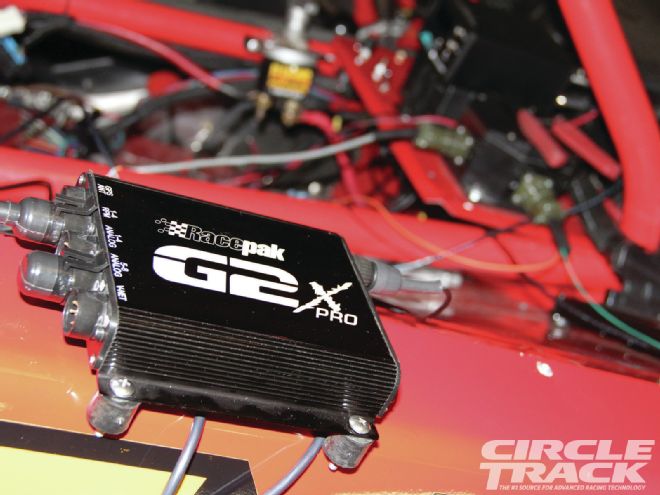 8. Racepak’s G2X Pro will handle all of the datalogging for the newly designed system that includes every aspect of what is happening in the car, from the EFI’s spark, to the temperature, horsepower, and even battery life.
8. Racepak’s G2X Pro will handle all of the datalogging for the newly designed system that includes every aspect of what is happening in the car, from the EFI’s spark, to the temperature, horsepower, and even battery life.
Speaking of the batteries, we are not just sticking in a second Exide. Nope, the guys at Argonne sourced a pair of high-tech rechargeable batteries to handle all of the Camaro's electrical needs. They are actually lithium-iron magnesium phosphate (LiFeMgPO4) batteries from Valence Technology. Two 12-volt batts are strategically placed where you would put your normal battery in an Asphalt Late Model. The batteries will power all of the car's electrical systems together, which is actually a departure from our original idea of one battery powering the water pump and p/s pump while the other powered the starter, ignition, and more. But Danny and Forrest said that running them together would be much better. The batteries also have their own on-board recharging system, now affectionately known as "that gray box" not to be confused with "that black box" which is actually part of a data logger system from Racepak. For this phase of the project we replaced the Motek unit we previously used for the Racepak you see in the pictures, because the Racepak unit allows us to gather all of the required data while simultaneously gathering and monitoring spark. The Motek unit would have required a separate system.
The Racepak logger draws the signal through something called the Smartwire, which utilizes a number of different sensors including a torque sensor and a fuel flow meter. While the latter is pretty obvious as to what it is, the torque sensor consists of two units, the aforementioned "black box" and a donut looking apparatus around the driveshaft. The torque sensor in cooperation with other sensors will allow us to see just how much of an effect the removal of the mechanically driven systems will have on horsepower output at the tailshaft. The entire system monitors every aspect of what is happening in the car, from the EFI's spark, to the temperature, horsepower, and even the batteries.
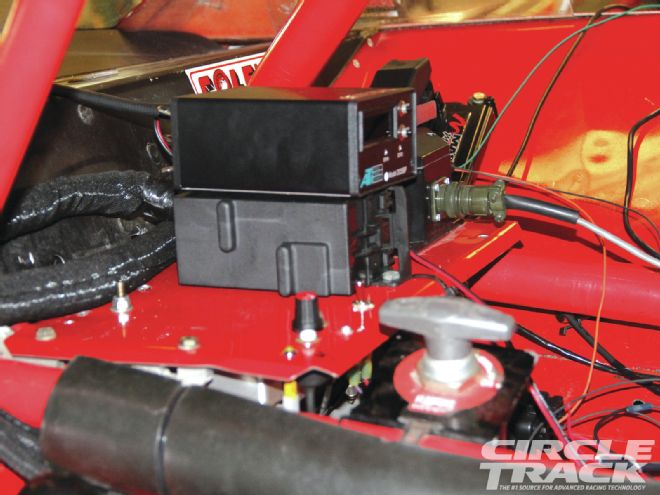 9. “That black box” on top with the antenna sticking out of the front is one half of the torque sensor, an integral part of proving whether or not the theory of removing the mechnicals from the front of the engine will actually give us an increase in horsepower.
9. “That black box” on top with the antenna sticking out of the front is one half of the torque sensor, an integral part of proving whether or not the theory of removing the mechnicals from the front of the engine will actually give us an increase in horsepower.
Of course, the basic structure of this system is actually the foundation for the hybridization we alluded to earlier in the story. Like Phase 1 of Project G.R.E.E.N., this phase is designed to push the envelope far beyond conventional thinking in oval track racing by applying cutting edge on-road vehicle systems to a fairly typical Super Late Model. This exercise is, however, just the tip of the iceberg so stay tuned for some really amazing things coming your way in 2013.
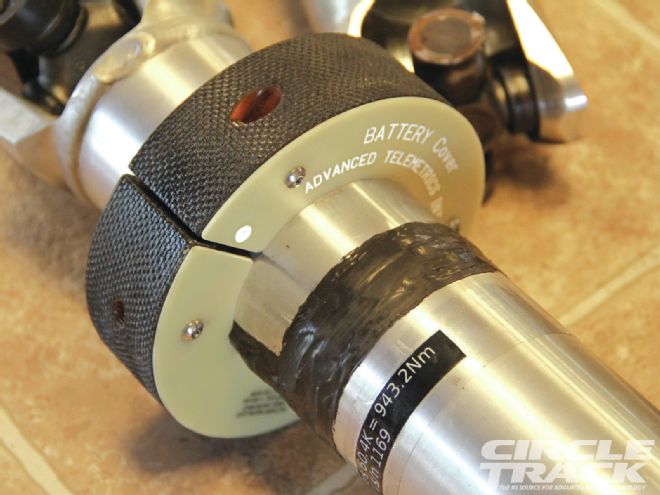 10. Here’s the other half of that system. The black donut looking item will measure, among other things, the torque output of the engine at the tailshaft of the transmission and wirelessly send that data to “that black box.”
10. Here’s the other half of that system. The black donut looking item will measure, among other things, the torque output of the engine at the tailshaft of the transmission and wirelessly send that data to “that black box.”
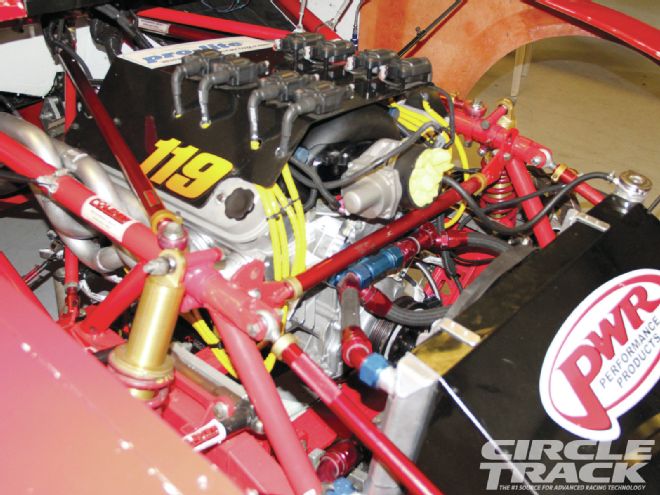 14. The finished product ready for testing shows a clean and simple front of Project G.R.E.E.N.’s LS3-based motor. Did we happen to mention that we did some extensive work on the internals of the CT525? Oh, we didn’t? Sorry about that, keep an eye out in future issues and we’ll tell you what we did.
14. The finished product ready for testing shows a clean and simple front of Project G.R.E.E.N.’s LS3-based motor. Did we happen to mention that we did some extensive work on the internals of the CT525? Oh, we didn’t? Sorry about that, keep an eye out in future issues and we’ll tell you what we did.